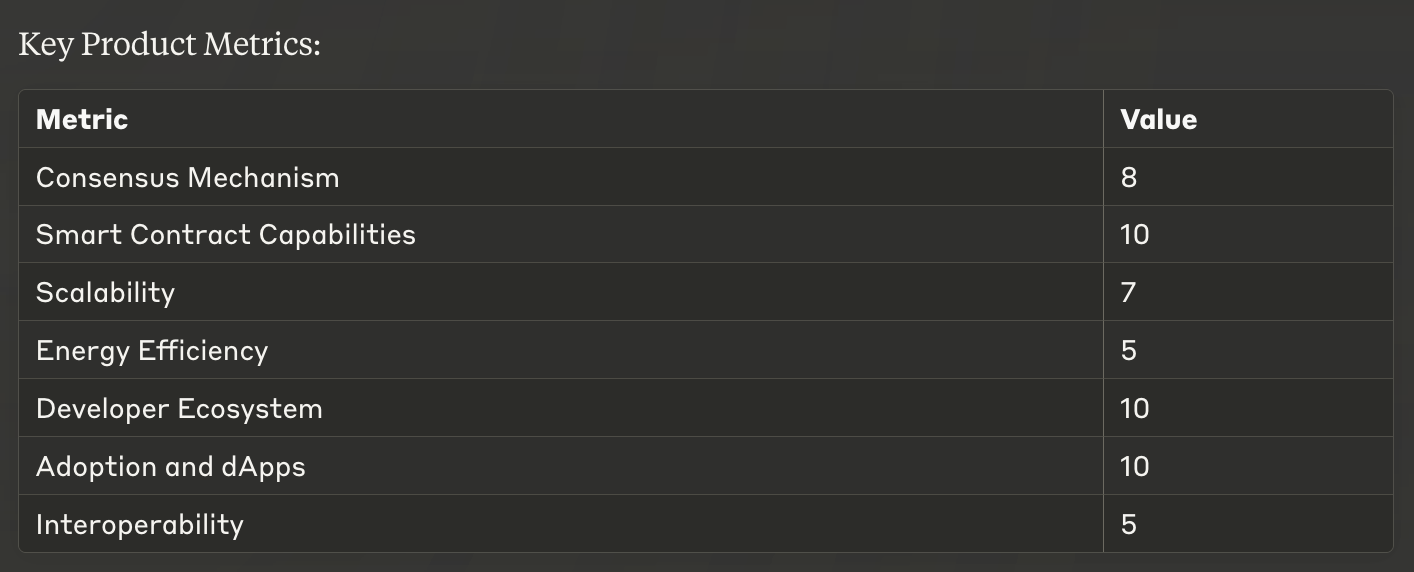Market Note: Contract Enabled Crypto-currency
Title: Product comparison
Ethereum Product Overview
Ethereum is a decentralized, open-source blockchain platform that has emerged as a leading player in the smart contract-enabled cryptocurrency landscape. Launched in 2013, Ethereum was founded by Vitalik Buterin and a team of developers with the goal of creating a platform that extends the capabilities of blockchain technology beyond just a digital currency.
Key Product Metrics
Title: Metrics
Key Product Attributes
Consensus Mechanism
Ethereum currently utilizes a Proof-of-Work (PoW) consensus mechanism, which secures the network through energy-intensive computational mining. However, the platform is in the process of transitioning to a Proof-of-Stake (PoS) consensus model, which is expected to significantly improve its energy efficiency.
Smart Contract Capabilities
Ethereum's primary strength lies in its robust smart contract functionality, which is facilitated by the Ethereum Virtual Machine (EVM). The platform's Turing-complete programming language, Solidity, enables developers to build a wide range of decentralized applications (dApps) with advanced capabilities.
Scalability
While Ethereum has faced scalability challenges, the platform continues to explore various solutions, such as layer-2 scaling approaches (e.g., Rollups), to improve its transaction throughput and processing speed.
Energy Efficiency
Ethereum's current PoW consensus mechanism is relatively energy-intensive, but the planned transition to PoS is expected to significantly enhance the platform's energy efficiency and reduce its environmental impact.
Developer Ecosystem
Ethereum boasts the largest and most mature developer community in the smart contract-enabled cryptocurrency space. This vibrant ecosystem has led to the creation of a vast array of dApps spanning various industries, including decentralized finance (DeFi), non-fungible tokens (NFTs), and more.
Adoption and dApps
Ethereum has achieved widespread adoption, with the highest number of active users and the most diverse range of decentralized applications among its peers. This broad-based adoption and the thriving dApp ecosystem are key strengths of the Ethereum platform.
Interoperability
While Ethereum has historically prioritized its internal ecosystem, the platform is now actively exploring solutions to improve its interoperability with other blockchain networks and enable seamless cross-chain integration.
As a CFO, Ethereum's capabilities in smart contracts, developer ecosystem, and broad adoption make it a compelling option for exploring various treasury management applications, such as automated payments, escrow management, and cross-border transactions. However, the platform's current scalability and energy efficiency challenges will require careful consideration and the evaluation of emerging solutions.
Polkadot Product Overview
Polkadot is a decentralized, open-source blockchain platform that has gained attention for its unique approach to interoperability and scalability in the smart contract-enabled cryptocurrency space. Launched in 2020, Polkadot was founded by Gavin Wood, a co-founder of Ethereum, along with a team of developers.
Key Product Attributes:
Consensus Mechanism
Polkadot utilizes a Nominated Proof-of-Stake (NPoS) consensus mechanism, which aims to provide a secure and energy-efficient approach to validating transactions and maintaining the network.
Smart Contract Capabilities
Polkadot supports various smart contract languages, including Solidity, Ink! (a domain-specific language), and WebAssembly, allowing developers to build a range of decentralized applications (dApps).
Scalability
Polkadot's unique "parachain" architecture, where individual blockchains (parachains) can be connected to the main Polkadot relay chain, enables parallel processing and improved scalability compared to traditional blockchain networks.
Energy Efficiency
Polkadot's NPoS consensus mechanism is generally considered more energy-efficient than Proof-of-Work (PoW) models, contributing to the platform's reduced environmental impact.
Developer Ecosystem
Polkadot has a growing developer community that is building on its Substrate framework, which provides a modular foundation for creating custom blockchains and decentralized applications.
Adoption and dApps
While Polkadot has a smaller number of decentralized applications compared to Ethereum, the platform is still in the process of onboarding and integrating more projects into its ecosystem.
Interoperability
Polkadot's primary focus is on enabling interoperability, allowing different blockchain networks to communicate and exchange data and assets. This cross-chain functionality is a key strength of the Polkadot platform.
As a CFO, Polkadot's emphasis on scalability, energy efficiency, and interoperability may make it an attractive option for treasury management applications that require high transaction throughput, reduced environmental impact, and the ability to integrate with various blockchain-based systems. The platform's growing developer ecosystem and adoption of decentralized applications are also promising signs for its long-term viability.


